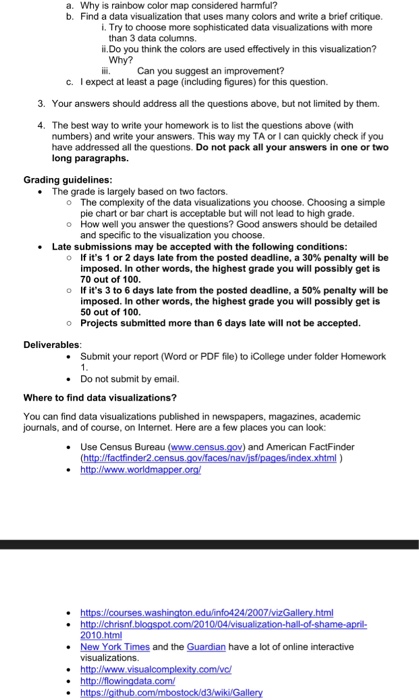Requirements In this homework, you will learn to analyze data visualization designs from both high level (e.g. Tufte's principles) and low level (e.g. the mapping between data and visual variables). Find Two examples of data visualizations and analyze each data visualization. a. Briefly describe the data visualization. Where do you find this data visualization? Who created it? What is the visualization about? 1. i. Try to choose more sophisticated data visualizations with 3 or more data columns. b. Describe the data. i. Create a list or a data table. You don't need to fill the table with data but try to create the framework of the table i.How many columns are in this spread sheet? what are the columns? What are the data types (e.g. tabular, spatial, temporal, network/tree, document, etc.)? For each column, is it quantitative, ordinal, or nominal data? c. Describe the visualization. i. Make a list of visual units used in the visualization. For each visual unit, make a list of visual variables used in the visualization. visual variable. well done? If not, why? ii.Create a table to show which data dimension is mapped to which Do you think the mapping between data and visual variables d. Use Edward Tufte's principles to analyze this visualization. Is this data visualization well designed? Is this an effective visualization? Point out which areas of the design are good or bad. If it's poorly designed, what design principles does it violate? e. Can you improve this data visualization? Iencourage you to create a revised visualization, like the ones at You don't have to create a detailed redesign. A sketch is fine. expect at least 1.5 pages of discussion for each visualization, including figures. f. 2. Read the following paper. Borland, D., Taylor, R.M.: Rainbow Color Map (Still) Considered Harmful. IEEE Computer Graphics and Applications 27(2), 14-17 (2007) Paper Link (click on "Raw to download it). Here's another related article. Requirements In this homework, you will learn to analyze data visualization designs from both high level (e.g. Tufte's principles) and low level (e.g. the mapping between data and visual variables). Find Two examples of data visualizations and analyze each data visualization. a. Briefly describe the data visualization. Where do you find this data visualization? Who created it? What is the visualization about? 1. i. Try to choose more sophisticated data visualizations with 3 or more data columns. b. Describe the data. i. Create a list or a data table. You don't need to fill the table with data but try to create the framework of the table i.How many columns are in this spread sheet? what are the columns? What are the data types (e.g. tabular, spatial, temporal, network/tree, document, etc.)? For each column, is it quantitative, ordinal, or nominal data? c. Describe the visualization. i. Make a list of visual units used in the visualization. For each visual unit, make a list of visual variables used in the visualization. visual variable. well done? If not, why? ii.Create a table to show which data dimension is mapped to which Do you think the mapping between data and visual variables d. Use Edward Tufte's principles to analyze this visualization. Is this data visualization well designed? Is this an effective visualization? Point out which areas of the design are good or bad. If it's poorly designed, what design principles does it violate? e. Can you improve this data visualization? Iencourage you to create a revised visualization, like the ones at You don't have to create a detailed redesign. A sketch is fine. expect at least 1.5 pages of discussion for each visualization, including figures. f. 2. Read the following paper. Borland, D., Taylor, R.M.: Rainbow Color Map (Still) Considered Harmful. IEEE Computer Graphics and Applications 27(2), 14-17 (2007) Paper Link (click on "Raw to download it). Here's another related article








